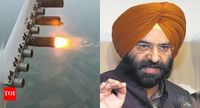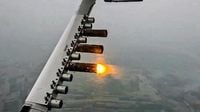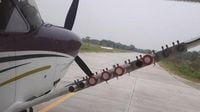As the Indian capital of Delhi grappled with choking smog and hazardous air quality in late October 2025, city officials turned to a high-profile experiment: cloud seeding, a weather modification technique designed to induce artificial rain and, hopefully, wash away airborne pollutants. The promise was alluring—could a technological intervention bring quick relief to millions breathing toxic air? Yet, as the dust settled (or rather, lingered), experts and real-time data painted a far more sobering picture.
On October 28, 2025, the Delhi government, in collaboration with researchers from the Indian Institute of Technology (IIT) Kanpur, carried out a much-publicized cloud seeding trial. Using a Cessna aircraft, fire flares loaded with silver iodide and sodium chloride were released into the sky above neighborhoods like Mayur Vihar and Burari, targeting the thick smog that had kept the city’s Air Quality Index (AQI) hovering between 300 and 400—nearly 20 times the safe limit, according to BBC News India. The hope was that these chemical agents would catalyze rainfall, scrubbing the sky clean of particulate matter.
The government soon claimed a modest victory. According to an official report, two small precipitation events were recorded in Noida (0.1 mm) and Greater Noida (0.2 mm) after the trials, and marginal decreases in pollution were observed in certain areas. Specifically, the PM 2.5 levels in Mayur Vihar, Karol Bagh, and Burari reportedly dropped from 221, 230, and 229 to 207, 206, and 203 respectively after the first seeding. Delhi’s environment minister, Manjinder Singh Sirsa, went so far as to claim reductions in particulate matter as high as 41.9% in PM10 at the trial sites, touting the effort as a science-driven step in the city’s clean air mission.
But as the initial excitement faded, skepticism from India’s scientific community grew louder. Meteorologist Gufran Beig, founder of the System of Air Quality and Weather Forecasting and Research (SAFAR), dismissed the results as a “foregone conclusion” and offered a blunt assessment: “Seeding clouds are not present at this time of the year. Even if they are, there is a 5 percent possibility for rain, and there is no guarantee that they will be properly seeded. I had said much before the trial itself that such kind of a shortcut solution is not going to make any difference. It is more of a fun fair rather than a serious attempt,” Beig told The Federal.
Beig’s doubts were echoed by real-time meteorological data. The India Meteorological Department (IMD) did not register any rainfall during the trials. “Even if there was any rainfall, it has not come to the ground; it must have washed away on the upper side of the atmosphere, which doesn’t make any difference as far as air quality is concerned. Success can only be measured if particulate matter washes away when there is rain. And they wash away only when there is heavy rain, which has not been seen anywhere,” Beig added.
Further complicating matters, the cloud seeding operation ran up against fundamental atmospheric limitations. Thara Prabhakaran, a cloud seeding expert from the Indian Institute of Tropical Meteorology (IITM), explained that Delhi’s autumn skies simply lack the right kind of clouds. “In Delhi, we have different layer clouds, or occasionally we have some convective storms in the layer. In the layer clouds, some of the clouds are very high up in the atmosphere. There is a very dry layer between two cloud layers, and even if the upper layer rains, it will evaporate in the subsequent layer,” she told The Federal. Shallow clouds, she noted, lacked sufficient liquid water content, and the atmosphere was overloaded with small aerosol particles—conditions that prevent droplets from growing large enough to fall as rain.
The limitations were not lost on IIT Kanpur’s own scientists. In a statement, the institute acknowledged that “the cloud-seeding activity planned for Oct 29 has been put on hold due to insufficient moisture in the clouds. The process is highly dependent on the right atmospheric conditions. While rainfall could not be triggered on Tuesday because moisture levels were around 15 to 20%, the trial delivered valuable insights.” The institute’s director, Manindra Agarwal, told BBC Hindi, “One measure of success is if it rains, which certainly did not happen. The moisture content in the clouds yesterday [Tuesday] was very low. We will continue our efforts in the near future.”
Despite the lack of rain, both the government and IIT Kanpur reported some measurable reductions in particulate matter. Real-time data from IIT Kanpur indicated a 6-10% reduction in PM2.5 and PM10 concentrations under limited moisture. Yet, experts cautioned against reading too much into these numbers. Beig pointed out that any small decline in AQI was likely due to natural variability, not the effects of cloud seeding: “If it (AQI) declined a little bit or increased a little bit, that is natural variability, which would have happened even without cloud seeding.” He also warned that drizzle, if it did occur, could actually worsen pollution by making the air heavier and causing particles to settle and multiply.
Other scientists agreed that only sustained, heavy rain over the entire Delhi-NCR region could meaningfully reduce pollution levels. “Drizzle will not help because in drizzle, the washout will be less, and to clean the pollution, you need rain over the entire Delhi-NCR to get a substantial reduction in air quality levels,” said IITM scientist Sachin Ghude. He added that such conditions are rare, occurring only with western disturbances and large cloud bases.
Given these constraints, the consensus among experts is clear: artificial rain is not a viable or long-term solution for Delhi’s air pollution crisis. “It (artificial rain) is not really a viable solution because too much infrastructure is needed right now. We have to develop so many things, and we have to have a very sound research strategy for implementing any such programmes,” said Prabhakaran. Ghude was even more direct: “There are no short-term options. You have to shut down the sources. We need proper management of emission sources, and not just targeting Delhi, but Delhi NCR and also beyond NCR.”
The root cause, nearly everyone agrees, lies in emissions—especially from vehicles. More than 60 percent of Delhi’s air pollution is caused by vehicles, and as D Raghunandan, former president of the All India People’s Science Network, told The Federal, “The solution is staring you in the face — which is to reduce the number of vehicles on the road. We know that more than 60 per cent of air pollution in Delhi is caused by vehicles. If that is the case, all policies must be directed to reduce the number of vehicles on the road and the only way to do that is to substitute personal vehicles with public mass transport.”
Meanwhile, the political debate rages on. AAP Delhi unit president Saurabh Bharadwaj criticized the cloud seeding efforts, noting that even the BJP-led central government had admitted in Parliament that, based on expert advice from IMD, CAQM, and CPCB, cloud seeding in Delhi was “scientifically impossible.”
As Delhi waits for the next round of cloud seeding—only to be attempted when moisture exceeds 30 percent, according to Minister Sirsa—the city’s residents are left with the same question: will science and technology deliver a miracle, or is the real solution far more down to earth?
For now, the evidence suggests that beating Delhi’s deadly smog will require more than a quick fix from the skies. It demands tough, systemic changes—starting with the way the city moves.


